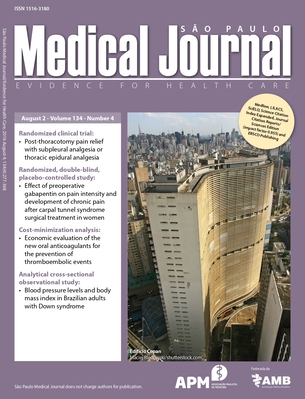Condutas hematológicas perante o mieloma múltiplo
tendências de um subgrupo de hematologistas brasileiros. Um estudo transversal
Palavras-chave:
Mieloma múltiplo, Hematologia, Condutas na prática dos medicos, Medicina baseada em evidências, Prática clínica baseada em evidênciasResumo
CONTEXTO E OBJETIVOS: Há nove anos, hematologistas e oncologistas se reúnem anualmente em um simpósio educacional organizado por um hospital brasileiro e outro norte-americano. Durante o Board Review 2015, uma pesquisa foi conduzida entre os participantes e avaliou as diferenças na conduta e opções de tratamento para o mieloma múltiplo (MM). DESENHO E LOCAL: Estudo transversal no simpósio educacional de hematologia em São Paulo. MÉTODOS: Hematologistas presentes no simpósio responderam a uma pesquisa por celular. RESULTADOS: Dos 350 inscritos, 217 responderam o questionário. A maioria dos participantes acredita que a terapia-alvo imune (iTA) pode ser efetiva para desacelerar a progressão do MM em pacientes que já foram muito tratados previamente, e que a exposição contínua à terapia pode gerar clones resistentes em pacientes com MM (76%). A maioria usa terapia de manutenção após transplante de células-tronco hematopoiéticas (95%) e 45% dos médicos a restringiriam a pacientes pós-transplante com doença de base de alto risco. As drogas de primeira linha adotada para os pacientes inelegíveis para transplante (PIT) foram bortezomibe-talidomida-dexametasona (31%), bortezomibe-dexametasona (28%), lenalidominadexametasona (Rd; 17%) e terapia baseada em melfalan (10%). A lenalidomida foi a droga de escolha para a manutenção pós-transplante para metade dos participantes. Nenhuma diferença significativa foi encontrada para idade ou tempo de experiência. CONCLUSÃO: As escolhas de tratamento para PIT foram altamente heterogêneas e o regime baseado em melfalan representou somente 10% das opções de primeira linha. Terapia de manutenção após transplante é opção comum. Alguns dos resultados do levantamento foram divergentes das evidências na literatura.
Downloads
Referências
Smith A, Howell D, Patmore R, Jack A, Roman E. Incidence of haematological malignancy by sub-type: a report from the Haematological Malignancy Research Network. Br J Cancer. 2011;105(11):1684-92.
Palumbo A, Anderson K. Multiple myeloma. N Engl J Med. 2011;364(11):1046-60.
Becker N. Epidemiology of multiple myeloma. Recent Results Cancer Res. 2011;183:25-35.
Hungria VT, Maiolino A, Martinez G, et al. Confirmation of the utility of the International Staging System and identification of a unique pattern of disease in Brazilian patients with multiple myeloma. Haematologica. 2008;93(5):791-2.
Hungria VTM, Maiolino A, Martinez GA, et al. Multiple myeloma profile in Latin America: clinical and epidemiological observational study. Blood. 2013;122(21):5327. Available from: http://www.bloodjournal.org/content/122/21/5327.article-info?sso-checked=true. Accessed in 2015 (Oct 14).
Minnicelli C, Maciel JF, Hassan R, Lemos TM. Clinical and epidemiological features of multiple myeloma patients from a low socio-economic region of Brazil. Rev Bras Hematol Hemoter. 2015;37(5):354-5.
Ayed AO, Chang LJ, Moreb JS. Immunotherapy for multiple myeloma: Current status and future directions. Crit Rev Oncol Hematol. 2015;S1040-8428(15):00124-9.
Phipps C, Chen Y, Gopalakrishnan S, Tan D. Daratumumab and its potential in the treatment of multiple myeloma: overview of the preclinical and clinical development. Ther Adv Hematol. 2015;6(3):120-7.
Plesner T, Arkenau HT, Lokhorst HM, et al. Safety and efficacy of daratumumab with lenalidomide and dexamethasone in relapsed or relapsed, refractory multiple myeloma. J Clin Oncol. 2014;32(Suppl):5s. [Abstract 8533]. Available from: http:// meetinglibrary.asco.org/content/131350-144. Accessed in 2015 (Oct 14).
Richardson PG, Laubach JP, Munshi NC, Anderson KC. Early or delayed transplantation for multiple myeloma in the era of novel therapy: does one size fit all? Hematology Am Soc Hematol Educ Program. 2014;2014(1):255-61.
San Miguel J. Multiple myeloma: a model for scientific and clinical progress. Hematology Am Soc Hematol Educ Program. 2014;2014(1):1-7.
Morgan GJ, Gregory WM, Davies FE, et al. The role of maintenance thalidomide therapy in multiple myeloma: MRC Myeloma IX results and meta-analysis. Blood. 2012;119(1):7-15.
Moreau P, Attal M, Facon T. Frontline therapy of multiple myeloma. Blood. 2015;125(20):3076-84.
Attal M, Lauwers-Cances V, Marit G, et al. Lenalidomide maintenance after stem-cell transplantation for multiple myeloma. N Engl J Med. 2012;366(19):1782-91.
McCarthy PL, Owzar K, Hofmeister CC, et al. Lenalidomide after stem-cell transplantation for multiple myeloma. N Engl J Med. 2012;366(19):1770-81.
Facon T, Mary JY, Hulin C, et al. Melphalan and prednisone plus thalidomide versus melphalan and prednisone alone or reduced- intensity autologous stem cell transplantation in elderly patients with multiple myeloma (IFM 99-06): a randomised trial. Lancet. 2007;370(9594):1209-18.
Wijermans P, Schaafsma M, Termorshuizen F, et al. Phase III study of the value of thalidomide added to melphalan plus prednisone in elderly patients with newly diagnosed multiple myeloma: the HOVON 49 Study. J Clin Oncol. 2010;28(19):3160-6.
Hulin C, Facon T, Rodon P, et al. Efficacy of melphalan and prednisone plus thalidomide in patients older than 75 years with newly diagnosed multiple myeloma: IFM 01/01 trial. J Clin Oncol. 2009;27(22):3664-70.
Fayers PM, Palumbo A, Hulin C, et al. Thalidomide for previously untreated elderly patients with multiple myeloma: meta-analysis of 1685 individual patient data from 6 randomized clinical trials. Blood. 2011;118(5):1239-47.
San Miguel JF, Schlag R, Khuageva NK, et al. Persistent overall survival benefit and no increased risk of second malignancies with bortezomib-melphalan-prednisone versus melphalan-prednisone in patients with previously untreated multiple myeloma. J Clin Oncol. 2013;31(4):448-55.
Engelhardt M, Terpos E, Kleber M, et al. European Myeloma Network recommendations on the evaluation and treatment of newly diagnosed patients with multiple myeloma. Haematologica. 2014;99(2):232-42.
Niesvizky R, Flinn IW, Rifkin R, et al. Community-Based Phase IIIB Trial of Three UPFRONT Bortezomib-Based Myeloma Regimens. J Clin Oncol. 2015;33(33):3921-9.
Facon T, Dimopoulos MA, Dispenzieri A, et al. Initial phase 3 results of the first (frontline investigation of lenalidomide + dexamethasone versus standard thalidomide) Trial (MM-020/IFM 07 01) in newly diagnosed multiple myeloma (ndmm) patients (PTS) ineligible for stem cell transplantation (SCT). Blood. 2013;122(21):2. [abstract]. Available from: http://www.bloodjournal.org/content/122/21/2.full.pdf. Accessed in 2015 (Oct 14).
Downloads
Publicado
Como Citar
Edição
Seção
Licença

Este trabalho está licenciado sob uma licença Creative Commons Attribution 4.0 International License.





